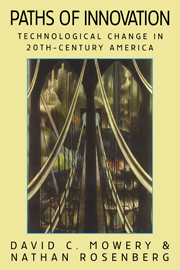2 - The Institutionalization of Innovation, 1900–90
Published online by Cambridge University Press: 05 June 2012
Summary
As we noted in the introductory chapter, no account of technological innovation in the 20th-century U.S. economy can confine itself to a discussion of specific sectors or technologies. Another central element in the evolution of all industrial economies during this century was the transformation of the structure and organization of the innovation process. Like many other important technological advances in these economies, the development of organized industrial research was pioneered in Western Europe during the 1870s by German chemicals firms. U.S. industrial firms in chemicals and other industries quickly emulated this development, however, and by the 1920s, U.S. firms were, collectively, the leading industrial employers of scientists and engineers.
The U.S. R&D system that originated in the early 20th century has undergone profound structural change during this century. This structural change has two broad components. The first is the rapid exploitation by U.S. firms of the “invention of the art of invention” pioneered in Germany. A second, related feature of the evolution of the U.S. R&D system during this century is the shifting roles of industry, government, and universities as funders and performers of R&D. The magnitude of the shifts in importance among these three sectors within the 20th-century United States may well exceed that associated with any other industrial economy.
- Type
- Chapter
- Information
- Paths of InnovationTechnological Change in 20th-Century America, pp. 11 - 46Publisher: Cambridge University PressPrint publication year: 1998
- 1
- Cited by



